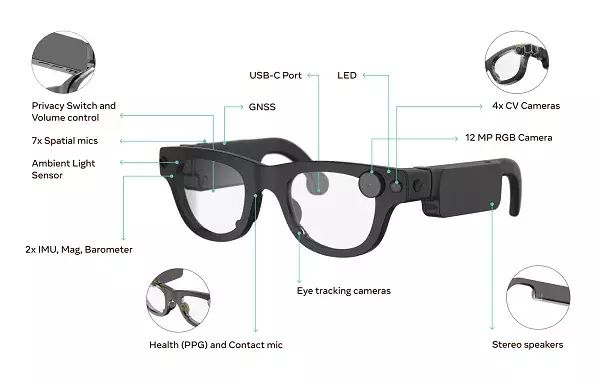Meta is pushing the boundaries of technology with its ambitious development of the second-generation “Aria” augmented reality glasses. This new model embodies more than just a tech upgrade; it’s a concept shift, a foundational step towards an entirely different way of engaging with our digital and physical worlds. As the company prepares for its retail launch, the insights shared about the Aria Gen 2 glasses reveal an intricate blend of innovation and practicality. Unlike its predecessors, this model promises to not only capture the imagination but also seamlessly integrate into daily life.
Enhanced Design Focus
One of the standout features of the Aria Gen 2 is its commitment to user comfort and aesthetics. Weighing in at a mere 74-76 grams, these glasses are designed with a diverse range of face shapes and sizes in mind, featuring eight different variations to ensure an optimal fit for anyone. The introduction of folding arms is not just a minor convenience; it marks a significant advancement. In a world where technology often sacrifices user experience for capabilities, Meta is proving that wearables can be both functional and stylish. This dual approach underlines the determination to create AR experiences that feel like an extension of the user rather than cumbersome gadgets.
Technological Advancements Across the Board
Alongside its sleek design, the Aria Gen 2 also boasts a suite of cutting-edge technological enhancements. The improved camera sensors promise superior performance in varying lighting conditions, addressing one of the common frustrations with augmented reality devices. With an expanded field of view, these glasses open up a broader visual interaction area, which is crucial for immersive user experiences. Furthermore, the integration of a contact microphone embedded within the nosepad demonstrates a thoughtful approach to audio capture, ensuring clarity even amidst noisy environments. This multifaceted enhancement indicates a shift towards making AR practical for real-world use.
A Leap towards the Future of Interaction
Meta CEO Mark Zuckerberg has referred to functional connected glasses as the “holy grail” in the technology realm, suggesting that these devices could eventually replace smartphones. This ambitious vision entails not just a passive viewing experience but an interactive one where users engage directly with the environment around them. Imagine a world where conversations involve hand gestures and virtual interactions happening right in front of you, all while you maintain eye contact with those around you. This may sound outlandish now, but given Meta’s continuous investment in innovation, such scenarios could become everyday occurrences sooner than we expect.
Collaboration and Community Development
Meta’s approach also invites creativity and collaboration from external developers, a strategy that encourages a diverse range of applications tailored to the unique capabilities of the Aria Gen 2. By opening the platform to developers, Meta is cultivating a community of innovation that stands to amplify the possibilities of augmented reality beyond its current limitations. The planned consumer launch in 2027 signals a readiness to enter a competitive market, but more importantly, it reflects Meta’s commitment to fostering an ecosystem where technology can adapt and grow through user and developer inputs.
Challenges on the Horizon
Despite the promising features and the forward-looking vision, challenges remain. The transition from imaginative tech to everyday utility is fraught with hurdles, from price accessibility to public acceptance. The notion of users gesticulating at thin air might raise eyebrows, but societal acceptance of new technologies often evolves quickly. The key for Meta will be to ensure that as the technology becomes more capable, it also remains relatable and easily integrated into day-to-day life. Overcoming skepticism will be critical in making AR glasses a mainstream tool rather than a novelty.
In the burgeoning landscape of tech innovation, Meta’s Aria glasses are undoubtedly on the cutting edge, poised to harmonize our physical and digital interactions in ways previously reserved for science fiction. As the launch approaches, the groundwork laid today may very well set the stage for a future where augmented reality tools genuinely enrich our experiences, redefining what it means to connect, engage, and interact in an increasingly digital world.


Leave a Reply